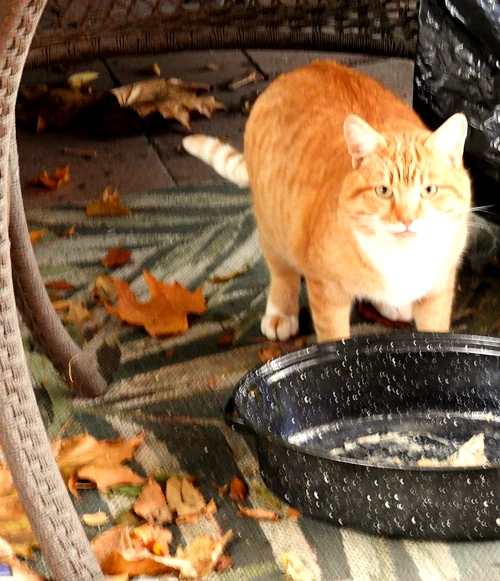By Clarice McKenney

My husband and I have had a Backyard Wildlife Refuge certified by the National Wildlife Foundation for 20 years. This means that our third of an acre on the south hill has sufficient fresh water, nourishment and shelter for wildlife. Through the years we occasionally have seen black bear, mountain lion and moose but on a daily basis host deer, raccoons, turkeys, skunks, fox squirrels and a wide variety of birds.
During this time three miniature Dachshunds, three long-haired cats and a short-haired tortoise-shell named Tootsie thrived inside and outside, thoroughly entertained by, and compatible with, the wildlife. I had all of our cats’ front claws removed so that their back claws allowed for self defense but not lethal attacks on the birds. All of them lived long, healthy and contented lives with our wildlife.
However, since Tootsie passed, our wildlife refuge has been inundated by stray cats. Our trail camera documents the presence of a beautifully patterned brown and white patterned male, a black and white female, a powder gray female; a beige, white and brown male, a striped male and a butterscotch and white one Rob calls “Max.” This cat is a big, intact male.
When I found this one sitting in our shade maple just above a feeder, I began feeding him. Little by little, Max has settled in and slithers around our legs, tripping us from time to time, even clawing and biting our ankles for attention (and more food). But he definitely will remain an outdoor cat.
Max shelters under our covered patio in a new, covered litter box with a pet heater. I plan to transport him to the veterinary office for neutering and declawing, hoping both procedures reduces his predation and tendency to hurt us. At the very least, he will be unable to create more cats.
I met Alice Miller, the woman I used to call “the Cat Nazi,” soon after moving here in ’97. By working with Dr. Roland Hall and a crew of volunteers, Alice developed the original Second Chance in Bonners Ferry and succeeded in all but eliminating stray cats in Bonners Ferry. Although Alice moved years ago, we have enjoyed the results of her hard work for many years.
In the breach left by Alice, my dear friend, retired teacher and former editor of “Northern Journeys,” Denise Thompson, is doing more than her share to minimize stray cats in her Valley View neighborhood. By last count, she has single-handedly safe-trapped and transported 19 cats to the vet for spay and neutering. On top of that, she and her rescued dog, Little Guy, host almost that many cats every day in her back yard as she provides shelter, water and food for all of them.
Our wonderful local animal shelter run by Second Chance is a non-profit working entirely by donations.
Shelter Manager Mickaelin Little told me more about the organization’s policies in sheltering cats.
“We do have to put people wanting to bring in both adults and kittens on a waiting list,” she said. “Since we have a small cat facility, we only take in a small amount of cats at a time. 10 cats is actually our limit (this excludes litters of kittens). This limit for our cat room exists to reduce illness and so we can properly care for every cat. When we first intake a cat or kittens, they have to be isolated from the other cats in our shelter for two weeks to ensure that they are healthy. If a cat does show signs of illness, they will be in isolation for even longer. While this isolation policy does make cats be on the waiting list longer, it is necessary to make sure that we are adopting out healthy cats. We are also not equipped to take in feral cats or cats with health problems.”
So that makes what Denise is doing that much more valuable to our community. She is working daily to help many unwanted cats plus preventing the birth of kittens who also would be unwanted strays. I will continue to shelter and feed Max and will follow Denise’s lead by getting this tom cat neutered.
According to Shelby Cowley at Bonners Ferry Veterinary Clinic, their program often assists people in spaying and neutering stray cats. The fund, to which members of our community contribute, honors Dr. Roland Hall’s beloved cat Buddy. Shelby explained when I called to schedule Max for the surgery that it strictly is for feral cats. That means cats that can not be safely handled and must be safe-trapped. She said that stray male cats that fall into this category are simpler than females that must be spayed, so males that are feral may be taken to the clinic for neutering any day as long as they come in by 8 a.m. via safe-trap.
Second Chance’s Mickaelin Little hopes county residents will, like Denise, help us solve our problem with cats, for our sakes and also for the sake of the cats some of us love. “I love that you are writing an article on the stray cat problem that we are facing as a community,” she said. “I don’t think the general public realizes how bad it truly is.
“I personally believe that one of the reasons we have so many strays is because people do not understand the many benefits of spaying and neutering their pet cats. And unless people are planning on trapping and releasing, they should not be feeding strays. Doing so only encourages stray cats to congregate, reproduce and spread disease.”
–end–
